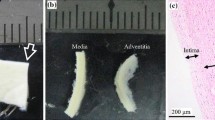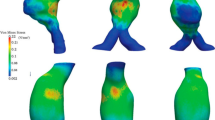Abstract
Rupture of the abdominal aortic aneurysm (AAA) occurs when the local wall stress exceeds the local wall strength. Knowledge of AAA wall mechanics plays a fundamental role in the development and advancement of AAA rupture risk assessment tools. Therefore, the aim of this study is to evaluate the biaxial mechanical properties of AAA tissue. Multiple biaxial test protocols were performed on AAA samples harvested from 28 patients undergoing open surgical repair. Both the Tangential Modulus (TM) and stretch ratio (λ) were recorded and compared in both the circumferential (ϴ) and longitudinal (L) directions at physiologically relevant stress levels, the influence of patient specific factors such as sex, age AAA diameter and status were examined. The biomechanical response was also fit to a hyperplastic material model. The AAA tissue was found to be anisotropic with a greater tendency to stiffen in the circumferential direction compared to the longitudinal direction. An anisotropic hyperelastic constitutive model represented the data well and the properties were not influenced by the investigated patient specific factors however, a future study utilizing a larger cohort of patients is warranted to confirm these findings. This work provides further insights on the biomechanical behavior of AAA and may be useful in the development of more reliable rupture risk assessment tools.




Similar content being viewed by others
References
Brown, P. M., D. T. Zelt, and B. Sobolev. The risk of rupture in untreated aneurysms: the impact of size, gender, and expansion rate. J. Vasc. Surg. 37:280–284, 2003.
Buijs, R., T. Willems, R. Tio, H. Boersma, I. Tielliu, R. Slart, et al. Calcification as a risk factor for rupture of abdominal aortic aneurysm. Eur. J. Vasc. Endovasc. Surg. 6:542–548, 2013.
Chaikof, E. L., D. C. Brewster, R. L. Dalman, M. S. Makaroun, K. A. Illig, G. A. Sicard, et al. The care of patients with an abdominal aortic aneurysm: the Society for Vascular Surgery practice guidelines. J. Vasc. Surg. 50:S2–S49, 2009.
Choi, H. S., and R. P. Vito. Two-dimensional stress–strain relationship for canine pericardium. J. Biomech. Eng. 112:153–159, 1990.
Choke, E., G. Cockerill, W. R. W. Wilson, S. Sayed, J. Dawson, I. Loftus, et al. A review of biological factors implicated in abdominal aortic aneurysm rupture. Eur. J. Vasc. Endovasc. Surg. 30:227–244, 2005.
Chuong, C. J., and Y. C. Fung. Compressibility and constitutive equation of arterial wall in radial compression experiments. J. Biomech. 17:35–40, 1984.
Darling, R., C. Messina, and D. Brewster. Autospsy of unoperated aortic aneurysms. The case of early resection. Circulation 56:164, 1977.
Di Martino, E. S., A. Bohra, J. P. Vande Geest, N. Gupta, M. S. Makaroun, and D. A. Vorp. Biomechanical properties of ruptured vs. electively repaired abdominal aortic aneurysm wall tissue. J. Vasc. Surg. 43:570–576, 2006.
Doyle, B., A. Callanan, P. Grace, and E. Kavanagh. On the influence of patient-specific material properties in computational simulations: a case study of a large ruptured abdominal aortic aneurysm. Int. J. Num. Methods Biomed. Eng. 29:150–164, 2013.
Doyle, B., T. McGloughlin, K. Miller, J. Powell, and P. Norman. Regions of high wall stress can predict the future location of rupture of abdominal aortic aneurysm. Cardiovasc. Interv. Radiol. 29:1–4, 2014.
Jacob, M. P. Extracellular matrix remodeling and matrix metalloproteinases in the vascular wall during aging and in pathological conditions. Biomed. Pharmacother. 57:195–202, 2003.
Kamenskiy A., Y. Dzenis, S. J. Kazmi, M. Pemberton, I. Pipinos, N. Phillips, et al. Biaxial mechanical properties of the human thoracic and abdominal aorta, common carotid, subclavian, renal and common iliac arteries. Biomech Model Mechanobiol. 2014. doi:10.1007/s10237-014-0576-6.
Kent, K. C., R. M. Zwolak, N. N. Egorova, T. S. Riles, A. Manganaro, A. J. Moskowitz, et al. Analysis of risk factors for abdominal aortic aneurysm in a cohort of more than 3 million individuals. J. Vasc. Surg. 52:539–548, 2010.
Lo, R., R. Bensley, A. Hamdan, M. Wyers, J. Adams, and M. Schermerhorn. Gender differences in abdominal aortic aneurysm presentation, repair, and mortality in the Vascular Study Group of New England. J. Vasc. Surg. 57:1261–1268, 2013.
Maier, A., M. Gee, C. Reeps, J. Pongratz, H. H. Eckstein, and W. Wall. A comparison of diameter, wall stress, and rupture potential index for abdominal aortic aneurysm rupture risk prediction. Ann. Biomed. Eng. 38:3124–3134, 2010.
Mofidi, R., V. Goldie, J. Kelman, A. Dawson, J. Murie, and R. Chalmers. Influence of sex on expansion rate of abdominal aortic aneurysms. Br. J. Surg. 94:310–314, 2007.
Newman, D. L., and R. C. Lallemand. The effect of age on the distensibility of the abdominal aorta of man. Surg. Gynecol. Obstet. 147:211–214, 1978.
O’Leary, S., B. Doyle, and T. McGloughlin. Comparison of methods used to measure the thickness of soft tissues and their influence on the evaluation of tensile stress. J. Biomech. 46:1955–1960, 2013.
O’Leary S., B. Doyle, and T. McGloughlin. The impact of long term freezing on the mechanical properties of porcine aortic tissue. J. Mech. Behav. Biomed. 37:165–173, 2014.
O’Leary, S., E. Kavanagh, P. Grace, T. McGloughlin, and B. Doyle. The biaxial mechanical behaviour of abdominal aortic aneurysm intraluminal thrombus: classification of morphology and the determination of layer and region specific properties. J. Biomech. 47:1430, 2014.
Polzer, S., T. Christian Gasser, J. Bursa, R. Staffa, R. Vlachovsky, V. Man, et al. Importance of material model in wall stress prediction in abdominal aortic aneurysms. Med. Eng. Phys. 35:1282–1289, 2013.
Raghavan, M. L., M. M. Hanaoka, J. A. Kratzberg, M. D. L. Higuchi, and E. S. da Silva. Biomechanical failure properties and microstructural content of ruptured and unruptured abdominal aortic aneurysms. J. Biomech. 44:2501–2507, 2011.
Raghavan, M., J. Kratzberg, E. Castro de Tolosa, M. Hanaoka, P. Walker, and E. da Silva. Regional distribution of wall thickness and failure properties of human abdominal aortic aneurysm. J. Biomech. 39:3010–3016, 2006.
Raghavan, M., M. Webster, and D. Vorp. Ex vivo biomechanical behavior of abdominal aortic aneurysm: assessment using a new mathematical model. Ann. Biomed. Eng. 24:573–582, 1996.
Reeps, C., A. Maier, J. Pelisek, F. Härtl, V. Grabher-Meier, W. A. Wall, et al. Measuring and modeling patient-specific distributions of material properties in abdominal aortic aneurysm wall. Biomech. Model. Mechanobiol. 12:717–733, 2013.
Sacks, M., and C. Chuong. Orthotropic mechanical properties of chemically treated bovine pericardium. Ann. Biomed. Eng. 26:892–902, 1998.
Sacks, M. S., and W. Sun. Multiaxial mechanical behavior of biological materials. Ann. Rev. Biomed. Eng. 5:251–284, 2003.
Schlosser, F. J., I. Vaartjes, G. J. van der Heijden, F. L. Moll, H. J. Verhagen, B. E. Muhs, et al. Mortality after elective abdominal aortic aneurysm repair. Ann. Surg. 251:158–164, 2010.
Stergiopulos, N., S. Vulliémoz, A. Rachev, J. J. Meister, and S. E. Greenwald. Assessing the homogeneity of the elastic properties and composition of the pig aortic media. J. Vasc. Res. 38:237–246, 2001.
Swedenborg, J., and P. E. R. Eriksson. The intraluminal thrombus as a source of proteolytic activity. Ann. NY Acad. Sci. 1085:133–138, 2006.
Tavares Monteiro J., E. Simão da Silva, M. Raghavan, P. Puech-Leão, M. Higuchi, and J. Otoch. Histologic, histochemical, and biomechanical properties of fragments isolated from the anterior wall of abdominal aortic aneurysms. J. Vasc. Surg. 59:1393–1401, 2013.
Thompson, M. M. Controlling the expansion of abdominal aortic aneurysms. Br. J. Surg. 90:897–898, 2003.
Thompson, S. G., L. C. Brown, M. J. Sweeting, M. J. Bown, L. G. Kim, M. J. Glover, et al. Systematic review and meta-analysis of the growth and rupture rates of small abdominal aortic aneurysms: implications for surveillance intervals and their cost-effectiveness. Health Technol. Assess. 17:1–118, 2013.
Thubrikar, M., M. Labrosse, F. Robicsek, J. Al-Soudi, and B. Fowler. Mechanical properties of abdominal aortic aneurysm wall. J. Med. Eng. Technol. 25:133–142, 2001.
Tong, J., T. Cohnert, P. Regitnig, and G. Holzapfel. Effects of age on the elastic properties of the intraluminal thrombus and the thrombus-covered wall in abdominal aortic aneurysms: biaxial extension behaviour and material modelling. Eur. J. Vasc. Endovasc. Surg. 42:207–219, 2011.
Tong, J., A. J. Schriefl, T. Cohnert, and G. A. Holzapfel. Gender differences in biomechanical properties, thrombus age, mass fraction and clinical factors of abdominal aortic aneurysms. Eur. J. Vasc. Endovasc. Surg. 45:364–372, 2013.
Vande, Geest J., E. Dillavou, E. Di Martino, M. Oberdier, A. Bohra, M. Makaroun, et al. Gender-related differences in the tensile strength of abdominal aortic aneurysm. Ann. NY Acad. Sci. 1085:400–402, 2006.
Vande, Geest J., M. S. Sacks, and D. Vorp. The effects of aneurysm on the biaxial mechanical behavior of human abdominal aorta. J. Biomech. 39:1324–1334, 2006.
Vande, Geest J., D. Schmidt, M. Sacks, and D. Vorp. The effects of anisotropy on the stress analyses of patient-specific abdominal aortic aneurysms. Ann. Biomed. Eng. 36:921–932, 2008.
Vardulaki, K. A., T. C. Prevost, N. M. Walker, N. E. Day, A. B. M. Wilmink, C. R. G. Quick, et al. Growth rates and risk of rupture of abdominal aortic aneurysms. Br. J. Surg. 85:1674–1680, 1998.
Vorp, P. C., D. H. J. Wang Lee, M. S. Makaroun, E. M. Nemoto, S. Ogawa, et al. Association of intraluminal thrombus in abdominal aortic aneurysm with local hypoxia and wall weakening. J. Vasc. Surg. 34:291–299, 2001.
Wanhainen, A., R. Themudo, H. Ahlstrom, L. Lind, and L. Johansson. Thoracic and abdominal aortic dimension in 70-year-old men and women—a population-based whole-body magnetic resonance imaging (MRI) study. J. Vasc. Surg. 47:504–512, 2008.
Acknowledgments
The authors would like to thank the Irish Research Council ‘EMBARK Initiative’ (Grant No. IDRS/2010/2941) for funding this study. BJD would like to acknowledge The University of Western Australia Research Fellowship and NHMRC Project Grant APP1063986. This work was supported by the Irish Government’s Programme for Research in Third Level Institutions Cycle 5, with the assistance of the European Regional Development Fund. The authors would also like to thank the Department of Vascular Surgery, University Hospital Limerick, Ireland, in particular Dr. Peter Coyle, for their help in harvesting and collecting the AAA tissue and also Caleb Horst for providing technical support for the Cellscale Biotester.
Conflict of interest
There are no conflicts of interest.
Author information
Authors and Affiliations
Corresponding author
Additional information
Associate Editor Peter E. McHugh oversaw the review of this article.
Electronic supplementary material
Below is the link to the electronic supplementary material.
Rights and permissions
About this article
Cite this article
O’Leary, S.A., Healey, D.A., Kavanagh, E.G. et al. The Biaxial Biomechanical Behavior of Abdominal Aortic Aneurysm Tissue. Ann Biomed Eng 42, 2440–2450 (2014). https://doi.org/10.1007/s10439-014-1106-5
Received:
Accepted:
Published:
Issue Date:
DOI: https://doi.org/10.1007/s10439-014-1106-5




